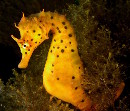 ‘Seahorses, Pipefishes, Pipehorses and Seadragons'.
‘Seahorses, Pipefishes, Pipehorses and Seadragons'.Big Belly Seahorse (Hippocampus abdominalis)
Family: Syngnathidae
Ten interesting facts about the Big Belly Seahorse
1. The Big Belly Seahorse ( Hippocampus abdominalis ) is a member of the Syngnathidae family which includes  ‘Seahorses, Pipefishes, Pipehorses and Seadragons'.
‘Seahorses, Pipefishes, Pipehorses and Seadragons'.
2. All seahorses are listed on Appendix II of CITES (Convention in International Trade of Endangered Species of Wild Flora and Fauna) meaning that international trade in seahorses is strictly regulated.
3. This species is also commonly referred to as the Pot Belly Seahorse and it is also scientifically known as Hippocampus bleekeri .

 4. Seahorses all belong to the one genus, Hippocampus, which is derived from the Greek words ‘hippos' (meaning horse) and ‘campus' (meaning sea monster).
4. Seahorses all belong to the one genus, Hippocampus, which is derived from the Greek words ‘hippos' (meaning horse) and ‘campus' (meaning sea monster).
5. This species can be found from Port Stephens in New South Wales around to the waters of South Australia . It also occurs in the waters of Tasmania and New Zealand.
 6. It can be easily identified by its large pot belly however its colouration can vary significantly as individuals can be yellow, grey, red, purple, brown and some even have a ‘tiger' pattern.
6. It can be easily identified by its large pot belly however its colouration can vary significantly as individuals can be yellow, grey, red, purple, brown and some even have a ‘tiger' pattern.
7. This seahorse is very popular with aquarium enthusiast and captive bred animals can often be seen for sale in aquarium stores.
 8. This species is not known to be socially monogamous (pairs remain together during the breeding period) as some other seahorses are.
8. This species is not known to be socially monogamous (pairs remain together during the breeding period) as some other seahorses are.
9. It can be found living amongst rocky reefs with Ecklonia cover as well as artificial structures such as shark nets and aquaculture fish cages. It is also known to occur in sponge gardens and kelp habitats.
10. This is one of the largest seahorse species growing to a maximum height of approximately 35cm.